Intelligent Cockpit Domain Control Unit (DCU) and Head Unit Dismantling Report, 2023 (1)
Dismantling of Head Unit and Cockpit Domain Control Unit (DCU) of NIO, Toyota and Great Wall Motor
The report highlights the dismantling of Toyota’s MT2712-based head unit, Fisker’s Intel A2960-based head unit, Great Wall Motor’s Qualcomm 8155-based head unit and NIO ET7 cockpit DCU, and estimates and analyzes Great Wall Motor’s head unit and NIO’s DCU.
This article takes NIO ET7 cockpit DCU we dismantle as an example.
"In terms of hardware, NIO ET7 packs a second-generation digital cockpit that is equipped with a 12.8-inch AMOLED center console screen, a 10.2-inch HDR digital cluster, a 6.6-inch HDR multi-function control screen in the rear row, and an enhanced head-up display (HUD) system. It runs the Banyan IVI System based on Qualcomm Snapdragon 8155 chip. The head unit carries the 16GB+256GB memory portfolio, supports multiple unlock methods like UWB digital key, and is equipped with some remote functions and AR-HUD system, as well as a built-in driving recorder.”
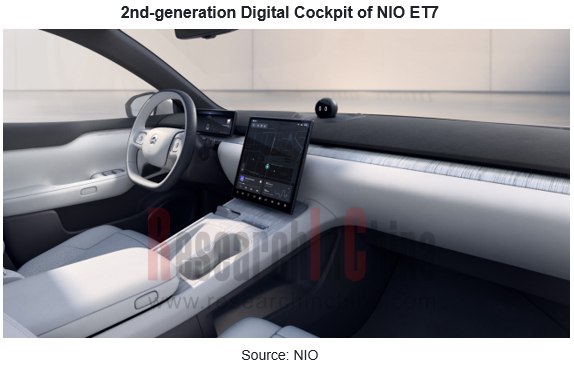
Appearance and interfaces
NIO ET7 bears NIO’s second-generation cockpit DCU. Compared with the first-generation, the SoC chip of the second-generation cockpit DCU is changed from Nvidia Parker to Qualcomm SA8155P. The second-generation cockpit DCU will be applied to all NIO models.
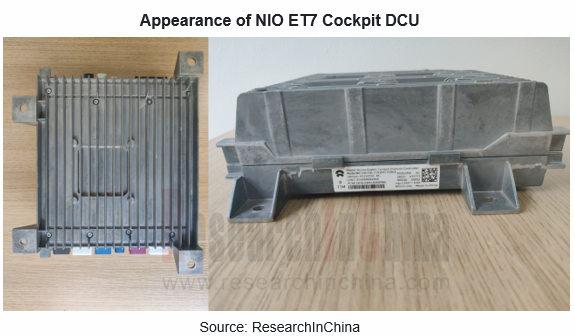
The interfaces on the lower side of the bottom view in the above picture, from left to right, are: center console display and rear display connector, cluster and HUD connector, 1 USB3.0 connector, 2 USB connectors, and 2 Ethernet connectors, and inside the white plastic sleeves are WiFi and Bluetooth antennas.
NIO ET7 cockpit DCU has a distinctive appearance. The heat sink on the backboard is recessed in the middle in a bid to be close to the SA8155P module that generates the most heat.
The interior of the housing of NIO ET7 cockpit DCU is relatively complicated. The inner layer of the housing is also embedded with a spongy material that absorbs impact. The holes on the right correspond to the two large capacitors on the PCB. The two capacitors are relatively high with ultra-large capacity up to 25 farads. They function as a battery. It is presumed that the two capacitors are added in the consideration of the fact that sometimes when a vehicle is parked for too long, the battery runs out of power but some wireless remote vehicle control functions still need to work.
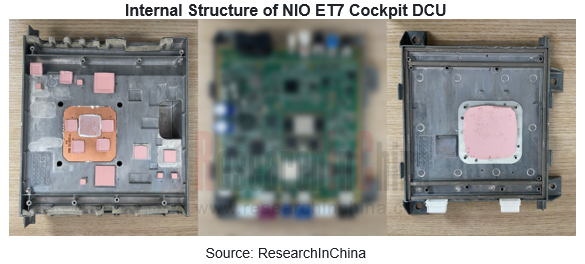
Unlike most vehicle PCBs with connectors on one side, NIO’s cockpit DCU PCB has connectors on both sides.
CPU and memory chip
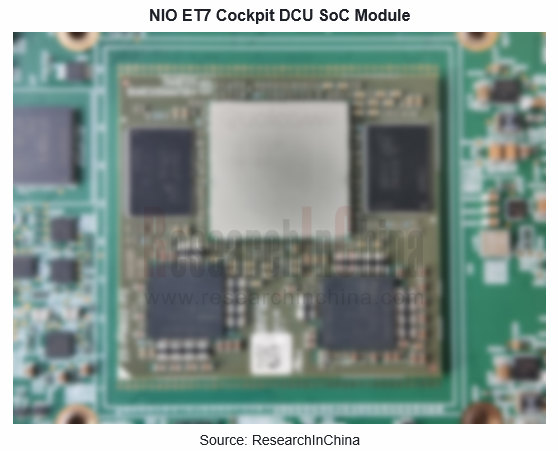
In the center of the DCU PCB lies the SoC module which accommodates one SA8155P chip, two PMM8155AU power management chips and two Micron memory chips.
Next to the capacitor side of the SoC module is a 256GB UFS 2.1 memory chip from Samsung. UFS 2.1 features working voltage of 1.8/3.3V, G3 2Lane interfaces, and temperature range of -40℃~105℃. The estimated price range of this chip is USD15-20.
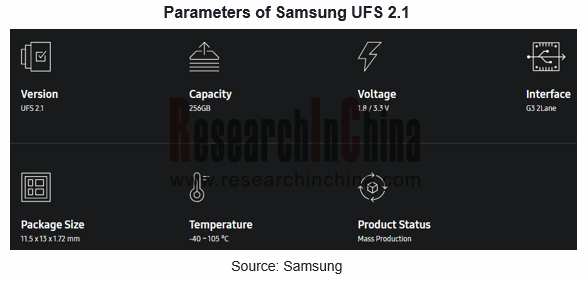
Ethernet switch
The relatively big chip next to the MCU and the capacitor is an 88EA6321 Ethernet switch provided by Marvell.
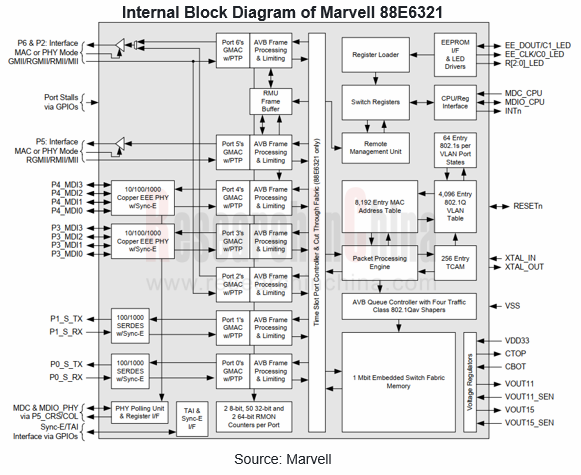
The picture above shows the internal framework of Marvell 88E6321, a 7-port Ethernet switch for automotive EAVB. 88E6321 carries two IEEE 10/100/1000BASE-T/TX/T interfaces (corresponding to RJ45, namely, a conventional registered jack as often said), two RGMII/xMII interfaces or one GMII interface, two SGMII/SerDes interfaces, and one RGMII/xMII interface. The MII (medium-independent interface) is a standard interface connecting the MAC and the PHY. It is an IEEE-802.3 defined Ethernet industry standard.
10/100/1000BASE-T/TX/T refers to the transmission cable. Port 2, 5 and 6 can be configured as MAC or PHY mode, and all support RGMII/RMII/MII. Port 2 and 6 also support GMII. Port 3 and 4 support 10M/100M/1000M adaptive Ethernet interfaces. Port 0 and 1 support 100M/1000M optical ports (SFP). 88E6321 launched around 2014 is an old product that does not support the latest TSN. It is not an automotive Ethernet switch in the strict sense, and is currently sold at a markdown price of about USD10-15. (MII refers to Medium Independent Interface; RMII, Reduced MII; SMII, Serial MII; GMII, Giga MII)
Video I/O
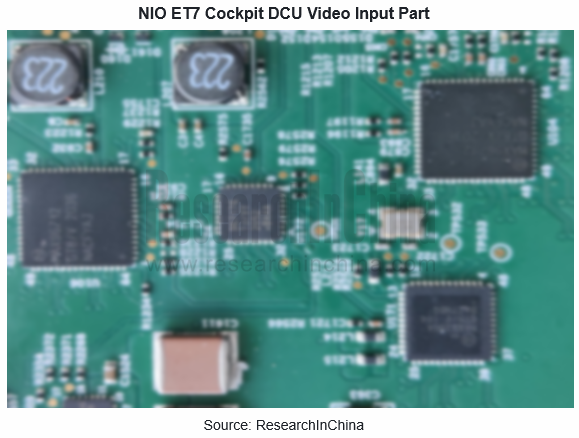
The picture above is the video input part of ET7 cockpit DCU. It uses a total of 4 serializer/deserializer chips (all from MAXIM, a company acquired by ADI), including two MAX96712 deserializer chips, one of which corresponds to the inputs of the four 3-megapixel surround-view cameras of NIO ET7.
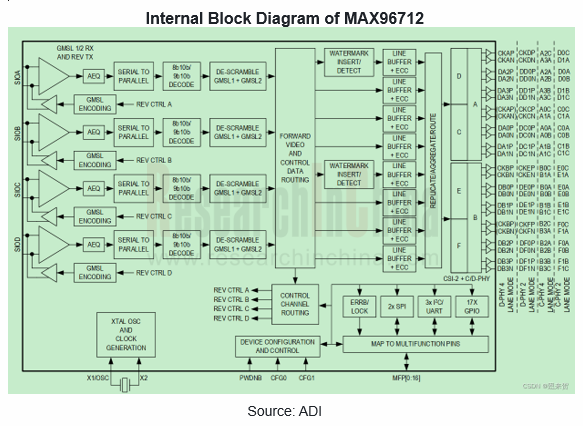
The picture above is the internal framework of MAX96712 which enables MIPI CSI-2 4Lane reception and delivers the maximum bandwidth of 6Gbps, that is, it can connect four 4-megapixel cameras and outputs two channels. It is currently the highest bandwidth deserializer chip priced at about USD15-20.
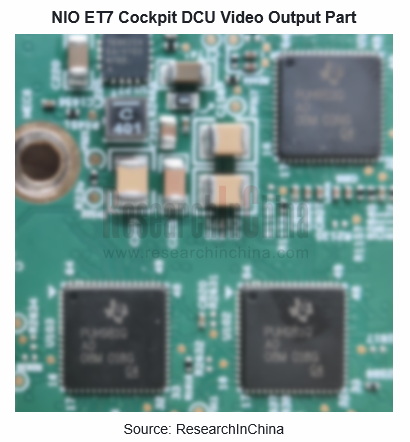
The video output part of NIO’s head unit in the picture above uses three TI serializer chips and video format conversion. All the three serializer chips require signing a non-disclosure agreement (NDA). SA8155 can support a variety of up to 24-megapixel display configuration interfaces (e.g., at most three 4K60 displays) via three native displays. It supports two 4-lane DSI D-PHY at 2.5 Gbps per lane or two 3-trio C-PHY at 5.7 Gbps per lane, an integrated display port shared with USB 3.1 Gen 2 at 8.1 Gbps/lane. It allows for 4K60 display ports concurrency and USB 3.0 operation, and enables other display single interfaces (DDSI) by using DisplayPort multi-stream transport (MST) and dual displays.
Back of PCB

There is a flying line on the front and back of the PCB. The flying line on the back is very obvious, about 4.5cm in length, which means that the PCB needs hand soldering in the end. This will affect efficiency and quality stability, and will also push up the overall cost of the cockpit DCU.
Passenger Car Intelligent Steering Industry Research Report, 2025-2026
Intelligent steering research: Rear-wheel steering prices drop to RMB200,000-250,000
1. Rear-wheel steering installations increased by 36.5% year-on-year.
From January to October 2025, the number of...
Global Autonomous Driving Policies & Regulations and Automotive Market Access Research Report, 2025-2026
Research on Intelligent Driving Regulations and Market Access: New Energy Vehicle Exports Double, and "Region-Specific Policies" Adapt to Regulatory Requirements of Various Countries in A Refined Mann...
Two-wheeler Intelligence and Industry Chain Research Report, 2025-2026
Two-Wheeler Electric Vehicle Research: New National Standard Drives Intelligent Popularization, AI Agent Makes Its Way onto Vehicles
ResearchInChina releases the "Two-wheeler Intelligence and Industr...
China Smart Door and Electric Tailgate Market Research Report, 2025
Smart Door Research: Driven by Automatic Doors, Knock-Knock Door Opening, etc., the Market Will Be Worth Over RMB100 Billion in 2030.
This report analyzes and researches the installation, market size...
New Energy Vehicle Thermal Management System Industry Research Report, 2025-2026
Policy and Regulation Drive: Promoting the Development of Electric Vehicle Thermal Management Systems towards Environmental Compliance, Active Safety Protection, and Thermal Runaway Management
Accord...
Intelligent Vehicle Redundant Architecture Design and ADAS Redundancy Strategy Research Report, 2025-2026
Research on Redundant Systems: Septuple Redundancy Architecture Empowers High-Level Intelligent Driving, and New Products Such as Corner Modules and Collision Unlock Modules Will Be Equipped on Vehicl...
Passenger Car Mobile Phone Wireless Charging Research Report, 2025
Automotive Wireless Charging Research: Domestic Installation Rate Will Exceed 50%, and Overseas Demand Emerges as Second Growth Driver.
The Passenger Car Mobile Phone Wireless Charging Research Repor...
Automotive 4D Radar Industry Research Report 2025
4D radar research: From "optional" to "essential," 4D radar's share will exceed 50% by 2030.
1. 4D imaging radar has transformed from an "optional" to a "must-have" sensor.
4D radar adds the detecti...
China Automotive Multimodal Interaction Development Research Report, 2025
Research on Automotive Multimodal Interaction: The Interaction Evolution of L1~L4 Cockpits
ResearchInChina has released the "China Automotive Multimodal Interaction Development Research Report, 2025"...
Automotive Vision Industry Report, 2025
Automotive Vision Research: Average Camera Installation per Vehicle Reaches 5.2 Units, and Front-View Tricam Installation Exceeds 1.2 Million Sets.
From January to September 2025, the total installa...
Automotive Infrared Night Vision System Research Report, 2025
Automotive night vision research: The rise of infrared AEB, with automotive infrared night vision experiencing a 384.7% year-on-year increase from January to September.
From January to September 2025...
New Energy Vehicle Cross-Domain (Electric Drive System and Powertrain Domain) Integration Trend Report 2025-2026
Electric Drive and Powertrain Domain Research: New technologies such as three-motor four-wheel drive, drive-brake integration, and corner modules are being rapidly installed in vehicles.
Electric dri...
Analysis on Desay SV and Joyson Electronic's Electrification, Connectivity, Intelligence and Sharing, 2025
Research on Desay SV and Joyson Electronic: Who is the No.1 Intelligent Supplier?
Both Desay SV and Joyson Electronic are leading domestic suppliers in automotive intelligence. "Analysis on Desay SV ...
OEMs and Tier 1 Suppliers' Cost Reduction and Efficiency Enhancement Strategy Analysis Report, 2025
ResearchInChina released the "OEMs and Tier 1 Suppliers' Cost Reduction and Efficiency Enhancement Strategy Analysis Report, 2025", summarizing hundreds of cost reduction strategies to provide referen...
Automotive Fixed Panoramic Sunroof and Smart Roof Research Report, 2025
With the intelligent application of car roofs as the core, this report systematically sorts out a series of new products such as fixed panoramic sunroof/openable sunroof, ceiling screen, roof ambient ...
Automotive-Grade Power Semiconductor and Module (SiC, GaN) Industry Research Report, 2025
SiC/GaN Research: Sales volume of 800V+ architecture-based vehicles will increase more than 10 times, and hybrid carbon (SiC+IGBT) power modules are rapidly being deployed in vehicles.
Sales volume o...
Cockpit Agent Engineering Research Report, 2025
Cockpit Agent Engineering Research: Breakthrough from Digital AI to Physical AI
Cockpit Agent Engineering Research Report, 2025 starts with the status quo of cockpit agents, summarizes the technical ...
Prospective Study on L3 Intelligent Driving Technology of OEMs and Tier 1 Suppliers, 2025
L3 Research: The Window of Opportunity Has Arrived - Eight Trends in L3 Layout of OEMs and Tier 1 Suppliers
Through in-depth research on 15 OEMs (including 8 Chinese and 7 foreign OEMs) and 9 Tier 1 ...